26.9 mph average wind speed yesterday.
44 F. high temperature Tuesday.
34 F. average high on March 7 in St. Cloud.
64 F. maximum temperature on March 7, 2016.
March 8, 2004: A vigorous Alberta Clipper brings an intense snow burst across the Twin Cities from 9:30 am to noon. 2.5 inches fell, with most of it accumulating in an hour at the State Climatology Office on the University of Minnesota St. Paul Campus. Numerous crashes were reported across the metro area with I-94 closed at Highway 280 and also at White Bear Avenue. In a rare scene, television programming was interrupted to report on the snow situation. By early afternoon most of the snow had moved into Wisconsin and road conditions rapidly improved.
March 8, 1892: A blizzard hits Minnesota, with 70 mph winds recorded at Easton. Duluth was hit especially hard with 60 mph winds causing large drifts. Residents were able to walk out of their second story windows.
Shirtsleeves. Tornadoes. Slush. Welcome to March
Maybe I'm getting old, but I find myself reflecting on some of the weather oddities I've witnessed over the years. 98.6 inches of snow the winter of 1983-84. Debilitating drought and heat in '88. Epic Red River flooding. The St. Peter and Comfrey tornadoes of 1998. 144 Minnesota tornadoes in 2010 (most in the USA). Flowers blooming in late March, 2012. And now the earliest tornado on record in Minnesota.
Monday's Zimmerman tornado was an EF-1 with 107 mph winds - 300 yards wide; on the ground for nearly 9 miles according to the National Weather Service (which had a Tornado Warning issued with plenty of lead time to take cover).
Another poignant reminder that the seasons are shifting. Expect the unexpected.
Another bad hair-day is likely today with wind gusts over 30 mph and a wind chill in the 20s. Highs may not climb out of the 20s Friday and Saturday; a Sunday clipper capable of slushing up lawns and dazed robins. But any snow won't last long; the sun is too high in the sky now.
40s return late next week, but Old Man Winter isn't nearly done with us just yet. Bundle up.
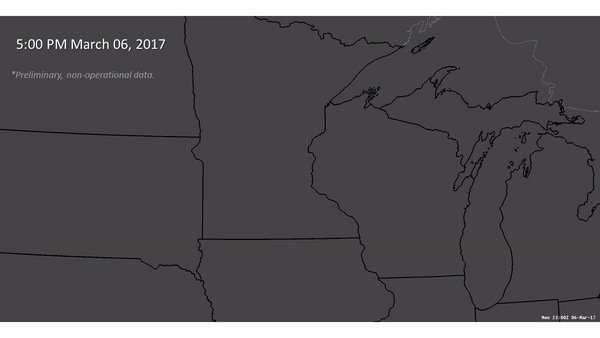 Earliest Known Tornado in Minnesota History. The previous record is March 18, 1968. We broke the record by nearly 2 weeks. Here's an excerpt from the Twin Cities National Weather Service: "On
March 06, 2017, an early spring severe weather outbreak produced large
hail and damaging wind in Wisconsin, and even tornadoes across
Minnesota. This marks the earliest date in Minnesota history that a
tornado was ever recorded. The previous record was March 18, 1968. The
loop to the right shows a comparison of visible and infrared satellite
imagery from the GOES16 satellite, along with radar reflectivity,
lightning, and warnings at 5:00 PM March 06, 2017. The line of
thunderstorms was located across Central Minnesota and extends southward
into Iowa..."
Earliest Known Tornado in Minnesota History. The previous record is March 18, 1968. We broke the record by nearly 2 weeks. Here's an excerpt from the Twin Cities National Weather Service: "On
March 06, 2017, an early spring severe weather outbreak produced large
hail and damaging wind in Wisconsin, and even tornadoes across
Minnesota. This marks the earliest date in Minnesota history that a
tornado was ever recorded. The previous record was March 18, 1968. The
loop to the right shows a comparison of visible and infrared satellite
imagery from the GOES16 satellite, along with radar reflectivity,
lightning, and warnings at 5:00 PM March 06, 2017. The line of
thunderstorms was located across Central Minnesota and extends southward
into Iowa..."Hundreds of Homes Damaged as Storms, Tornadoes Batter Midwest. Here's an excerpt of a good overview from USA TODAY: "...A severe storm system pummeled parts of the Midwest overnight with tornadoes, huge hailstones and powerful winds, damaging nearly 500 buildings and injuring a dozen people in one Missouri city. The Storm Prediction Center in Norman, Okla., received reports of more than 30 tornadoes in Kansas, Missouri, Iowa and Illinois late Monday and early Tuesday. Powerful winds extended as far south as the Ozark Mountains in Arkansas, where a post office and church were damaged, and as far north as Wisconsin, where trees were downed. In Oak Grove, Mo., 483 homes sustained some type of damage, along with 10 to 12 commercial buildings, said Sni Valley Fire Protection District Chief Carl Scarborough..."
Image credit: WKRN; Image: Chris Gullikson.

Earliest Ice-Outs on Minnesota Lakes. Ice out on Lake Calhoun already? That's nearly a month ahead of schedule. Check out the stats on your favorite lake at the Minnesota DNR.
Earliest Ice-Out On Record for Lake Minnetonka? If the ice comes off before March 11 we may have a new record on 'Tonka. Data courtesy of The Freshwater Society.
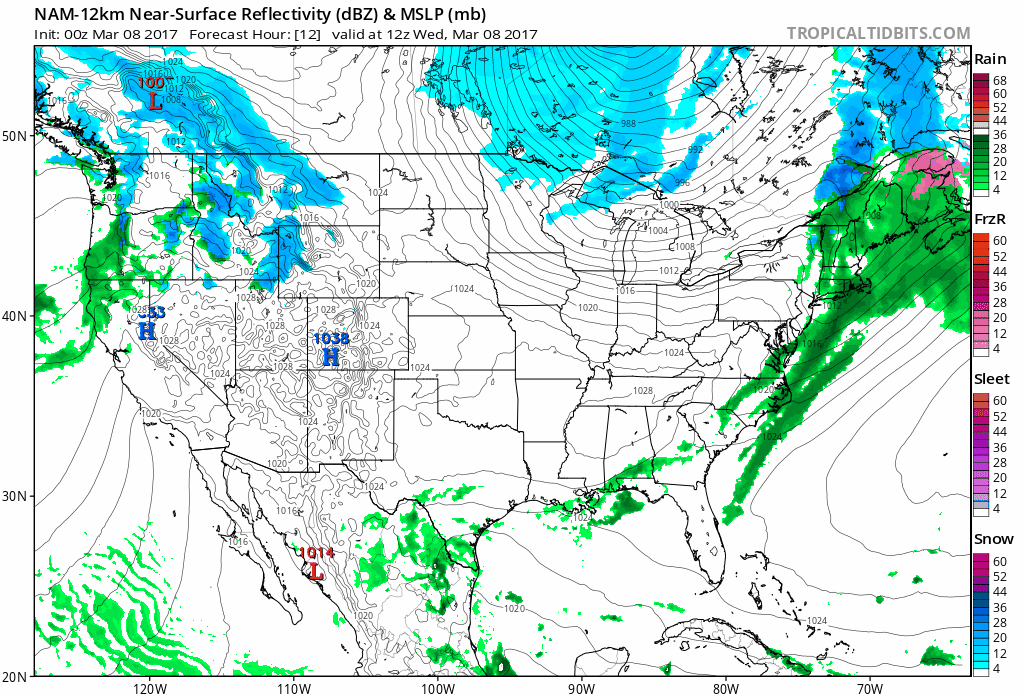
Family of Clippers. No big, sprawling, full latitude blockbuster storms are brewing, but a series of small, fast-moving Alberta Clippers will spread fingers of snow from the Northern Plains to the Mid Atlantic as waves of colder air pulse into America. More rain for Seattle and the Pacific Northwest. Who would have guessed? 84-hour Future Radar product: NOAA and Tropicaltidbits.com.
Cold Correction, Then Warming Up Again Next Week.
No more 60s for at least a few weeks, although ice-out and spring
green-up will happen about 2-4 weeks early for many communities. After a
run of 20s into the weekend 40s will feel just fine by the end of next
week. ECMWF guidance: WeatherBell.
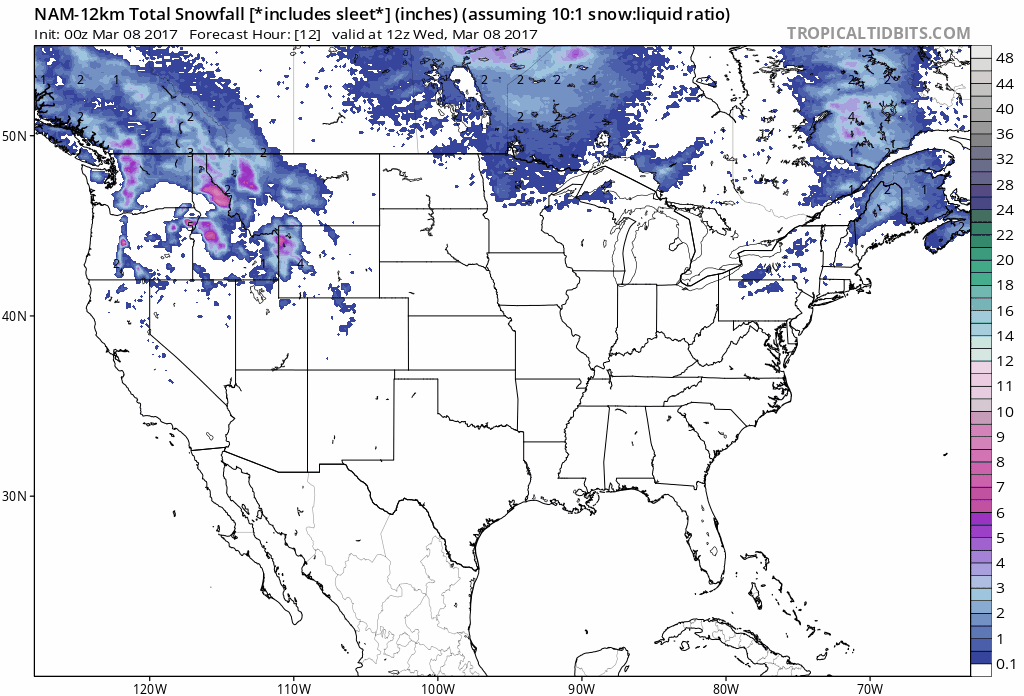 Snowfall Potential Into Saturday Morning.
Waves of colder-than-average air splashing south of the border spin up a
series of fast-moving clippers into the weekend. A couple inches may
slush up Pennsylvania Friday; another clipper late Friday and Saturday
may put down a carpet of white from Rapid City to Omaha and Des Moines.
Snowfall Potential Into Saturday Morning.
Waves of colder-than-average air splashing south of the border spin up a
series of fast-moving clippers into the weekend. A couple inches may
slush up Pennsylvania Friday; another clipper late Friday and Saturday
may put down a carpet of white from Rapid City to Omaha and Des Moines.
Winter is Not Coming. We Need Winter.
There will be occasional "polar vortex" winters, but they may become
the exception, not the rule, as the atmosphere continues to warm. Here's
an excerpt from ThinkProgress: "...In
nature, timing is everything. In a spring, flowers lend their nectar to
bees, and bees pollinate those flowers. When flowers bloom too soon,
however, they risk losing their petals and nectar before bees show up.
Fewer bees mean less pollination, and so forth. But if both species
resurface at the onset of spring, why would they fall out of sync? The
answer is that they respond to different cues. Some plants, like Washington’s cherry trees,
bloom after experiencing several warms days in a row. Others respond to
sunlight, blossoming only after days grow longer. Pollinators — such as
birds, bees, bats, and butterflies—have evolved to take advantage of
these subtle, seasonal cues. In a normal year, these cues more or less
line up as anticipated, leading the birds and the bees to discharge
their vernal duties at roughly the appropriate time. But climate change
is blurring the line between winter and spring — a phenomenon scientists
call season creep — and many species of both flora and fauna are struggling to adapt..." File photo: A flower withers in a late-season frost." CREDIT: USDA
Photo credit: "Water being released from Lake Oroville Dam on Feb. 14. Enough water has spilled out of the rain-swollen California lake to meet the demands of roughly 14 million people for a year." Photo: jim urquhart/Reuters.
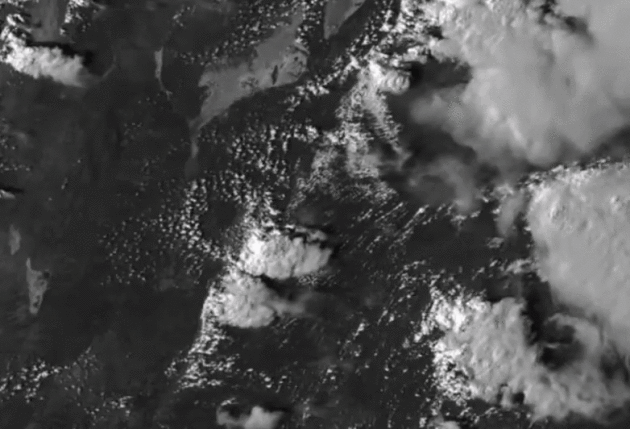
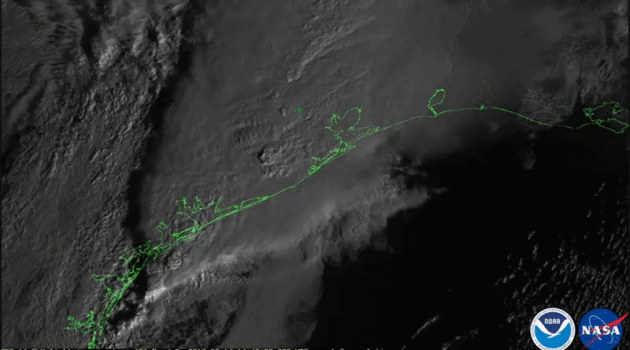
GOES-16: 100x Increase in Data. Check out this backgrounder on the new (amazing) GOES-16 satellite from UCAR: "...But the advantages of GOES-16 also create new challenges. The satellite has three times as many spectral channels as its predecessors, each with four times more resolution. It can scan the entire Western Hemisphere every 15 minutes and simultaneously generate images of severe weather every 30-60 seconds. All this data will amount to about 1 terabyte per day, more than 100 times the amount of data produced by an existing GOES satellite. And even more data can be expected when NOAA launches additional advanced GOES satellites in coming years..."
Climate Scientists and Weather Forecasters Outraged by Proposed Cuts to NOAA. Jason Samenow reports at Capital Weather Gang: "...NOAA, which is part of the Department of Commerce, houses the National Weather Service and the divisions responsible for weather satellites and atmospheric research. The weather satellite division, known as the National Environmental Satellite, Data and Information Service, would be hardest hit by the proposed cuts. The administration proposes slashing its budget by $513 million in the 2018 fiscal year, which starts Oct. 1. Data from weather satellites are indispensable for models used to predict the weather. NOAA has conducted experiments that show that forecasts for costly and deadly storms would be far less accurate without such information..."
Image credit: "Visualizations of Hurricane Sandy in 2012." (Mel Shapiro, NCAR).
The High Toll of Costly Water: Who Will Pay for America's Quiet Water Crisis? Here's a clip from an eye-opening article at Fusion: "...Mack, along with research assistant Sarah Wrase, determined that if water rates increase at projected amounts over the next five years, the percentage of households that can’t pay their water bills could triple from 11.9% to more than a third. Nearly 14 million households nationwide already struggle to afford water services. An additional 27.18 million—or 8.5% of the country’s population—could soon face the same challenges. “I don’t think we think about this, about what it would mean to not have running water,” Mack told Fusion. Of course, some Americans have experienced it. Water affordability is becoming an increasingly critical issue in cities across the country, including Philadelphia, Atlanta, Seattle, and Detroit. In Philadelphia, an estimated four out of 10 water accounts are past due. Atlanta and Seattle have some of the highest water rates in the country..." (Image credit: NOAA).
Photo credit: "Indian pedestrians cover their faces amid heavy dust and smog in New Delhi." (Harish Tyagi/European Pressphoto Agency)
Wind Power: A New Cash Crop for Minnesota Farmers. Here's an excerpt of an update from Wind On The Wires: "...Rural
communities have much to gain from welcoming a wind project into their
community. Wind development projects inject millions of dollars into
the local economy. This happens in a few ways. First, developers
strive to buy local goods and services whenever possible. They use
local restaurants, grocery stores, hotels, hardware stores, service
stations, building and construction supply companies, print shops, and
other services as much as possible. This gives a real boost to local
businesses. After construction, good-paying permanent jobs remain for
service technicians and administrative personnel. Second, wind energy
has become a new “cash crop” for many farmers and ranchers. U.S. wind
farms now pay an estimated $245 million a year to farming families. At
the end of 2015, AWEA reported that 70 percent of that revenue goes to
landowners who live in counties with below average incomes, providing a
welcome source of new income..."
TODAY: Cold and blustery. Winds: NW 15-30. High: 36
WEDNESDAY NIGHT: Partly cloudy. Low: 20
THURSDAY: Patchy clouds, but less wind. Winds: N 7-12. High: 35
FRIDAY: Partly sunny, February flashback. Winds: N 8-13. Wake-up: 10. High: 24 Morning windchills dipping below 0F.
SATURDAY: Mostly cloudy, flurries possible. Winds: NE 5-10. Wake-up: 13. High: 27
SUNDAY: Next clipper, chance of slushy lawns. Winds: SE 8-13. Wake-up: 16. High: 31
MONDAY: Drying out, still a little chilly for March. Winds: NW 8-13. Wake-up: 17. High: 32
TUESDAY: Intervals of sun, cooler than average. Winds: SE 7-12. Wake-up: 19. High: 36
Climate Stories....
Carbon Dioxide Could Reach 410 PPM This Month. Climate Central has the details: "A never-ending stream of carbon pollution ensures that each year the world continues to break records for carbon dioxide in the atmosphere. This year will be no different. Like a rite of spring, carbon dioxide is poised to cruise pass the previous mark set last year and reach heights unseen in human history. In the coming weeks, carbon dioxide will start to breach the 410 parts per million threshold on a daily basis at the Mauna Loa Observatory in Hawaii. The monthly average for May could come close to topping 410 ppm, too, according to the U.K. Met Office’s inaugural carbon dioxide forecast, released last week..."
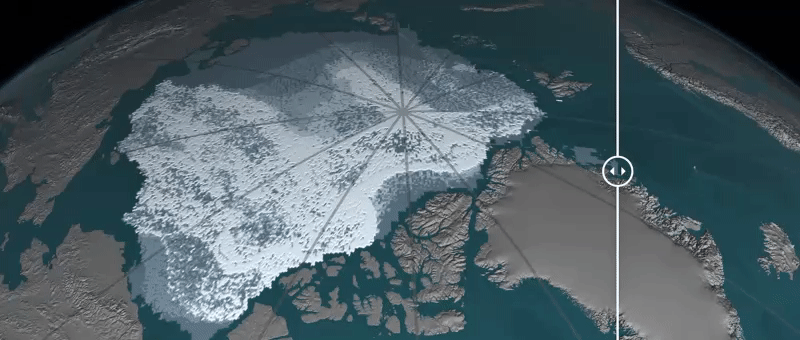
Arctic Sea Ice May Vanish Even If World Achieves Climate Goal: Study. Here's a story excerpt from Reuters: "Arctic sea ice may vanish in summers this century even if governments achieve a core target for limiting global warming set by almost 200 nations in 2015, scientists said on Monday. Arctic sea ice has been shrinking steadily in recent decades, damaging the livelihoods of indigenous peoples and wildlife such as polar bears while opening the region to more shipping and oil and gas exploration. Under the 2015 Paris Agreement, governments set a goal of limiting the rise in average world temperatures to well below 2 degrees Celsius (3.6 Fahrenheit) above pre-industrial times, with an aspiration of just 1.5C (2.7F). "The 2 degrees Celsius target may be insufficient to prevent an ice-free Arctic," James Screen and Daniel Williamson of Exeter University in Britain wrote in the journal Nature Climate Change after a statistical review of ice projections..."
Image credit: Difference in September ice from 1984 to 2016. NOAA and NASA.
The Republican Mayor is Bucking his Party to Stand Up for Climate Action. ThinkProgress has the story: "...That’s
because to six-term mayor and lifelong Republican Jim Brainard, making
his city more sustainable — and reducing Carmel’s contribution to
climate change — isn’t a liberal issue. It’s an issue that speaks to his
vision of conservatism, and he deeply believes more Republican leaders
should start speaking up about climate change as well. “I somewhat
regret not speaking out sooner,” he told ThinkProgress. “There’s a lot
of Republicans out there that think like I do. They have been
intimidated, to some extent, by the Tea Party and the conservative talk
show hosts. But at a certain age, you just don’t care. You think, ‘I’m
going to say what I think and what I think is best for my constituents.’
If you do that, I think it comes through to the voters...”
Photo credit: "Mayor Jim Brainard in his office in Carmel, Indiana." CREDIT: Tom Britt
James Balog on Climate Change: "It's a Tragedy That It's Been Politicized". Here's an excerpt of a story at Sarasota's Herald-Tribune: "...We
have lived in a fairly narrow zone of temperature and moisture for the
last 10,000 years," Balog said. "To ignore (climate change), we're
basically gambling in our world." Although climate change
has been a controversial topic politically, Balog rejected those who
view it as a partisan topic. Instead, he said climate change is simply
an objective fact regardless of political party. "It's a tragedy that the issue has been politicized," Balog said. "It never should've been turned into political football." At that statement, nearly the entire audience began to applaud..."
Photo credit: "The Mendenhall Glacier in Alaska was photographed by James Balog in 2015 for the Extreme Ice Survey project." Ccurtesy: James Balog.
How Climate Change Will Stress the Grid And What ISO's Are Doing About It. Here's a story snippet from Utility Dive: "...But while climate change skeptics wring their hands over the theoretical costs of global warming, the nation’s electricity system operators are already feeling it — and planning for its future effects. Average temperatures are rising across the U.S., pushing grid operators to examine whether they have adequate capacity to meet higher power demand and sharper spikes in peak load. Projected temperature increases will raise average electricity demand 2.8% across the U.S. by the end of the century, according to a new National Academy of Sciences study. The impact is expected to be greatest in the summer months, when cooling load is already high; the study projects a 3.5% increase in average peak demand over the same timeframe..." (Image credit: Department of Energy).
Graphic credit: "Only 50% of the survey participants thought that climate change was mainly due to human activities. Just 29% think it is mainly natural. This shows there is still a lingering disconnect between weathercasters and the atmospheric science community."
Jobs Take Center Stage of Climate Change Debate in Trump Era. Here's an excerpt from Bloomberg: "...Many Republicans, including the president, have been unmoved by environmental or scientific arguments that federal policies should support clean energy as a way to combat global warming. They may be swayed by the 360,000 jobs provided by wind and solar in the U.S. last year, business executives and environmentalists said Friday at a climate-change conference in Chicago. Economics have long been at the center of arguments supporting wind and solar power. But as President Donald Trump pushes to boost fossil fuel production and cede U.S. leadership on fighting climate change, clean energy advocates are talking about employment more than ever. “There is nothing that matters more to politicians than jobs and ribbon cuttings,’’ Bob Keefe, executive director of the non-profit group Environmental Entrepreneurs, said during a speech at the event. “They need to hear from business people that this is driving growth...’’
Inside the Quest to Monitor Countries' CO2 Emissions. From commercial aircraft to satellites, we need cost-effective ways to measure greenhouse gas emissions. Here's a clip from Scientific American: "...While some space satellites can measure greenhouse gas emissions, they are expensive, depend on computer models and “have all kinds of biases” that make it difficult to reach the precision needed to accurately measure man-made emissions, explained NOAA’s Tans. NASA has recently selected a more sophisticated satellite for a launch in 2022, however, that offers some hope. It is called the Geostationary Carbon Cycle Observatory (GeoCARB), and would hover 22,000 miles in space, rotating with a constant view of most of the Americas. It comes with a bargain basement price (for a satellite) of $166 million over the next five years, partly because it will hitchhike a ride into space sitting in an unused area of a payload carrying a commercial communications satellite..."
Image credit: "This is an artist’s concept of the Orbiting Carbon Observatory. The mission, scheduled to launch in early 2009, will be the first spacecraft dedicated to studying atmospheric carbon dioxide." Credit: NASA, JPL
100 Years Ago Alexander Graham Bell Warned Us About the "Greenhouse Effect". Here's a clip from ThinkProgress: "In a 1917 paper,
Alexander Graham Bell wrote that the unrestricted burning of fossil
fuels “would have a sort of greenhouse effect.” The man who invented the
telephone four decades earlier added, “the net result is the greenhouse
becomes a sort of hot-house.” Bell was also concerned about the
inevitable depletion of fossil fuels — “What shall we do when we have no
more coal and oil?” So in a 1917 article
for National Geographic Magazine, he urged the development of renewable
ethanol fuel from agricultural waste, corn stalks, and saw-mill dust.”
As one biographer wrote, Bell would “also explore ideas in energy conservation” and “solar heating...”
Photo credit: "Alexander Graham Bell at the opening of the long-distance line from New York to Chicago." CREDIT: Library of Congress, text by Patrick Smith, ThinkProgress.

No comments:
Post a Comment